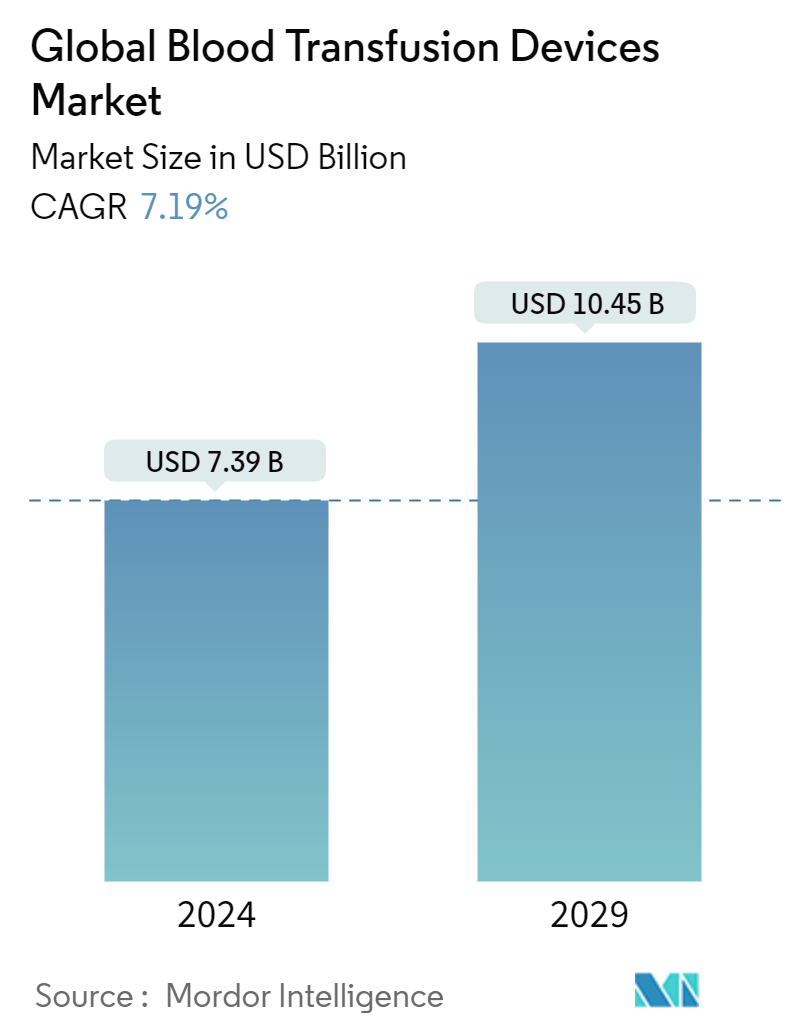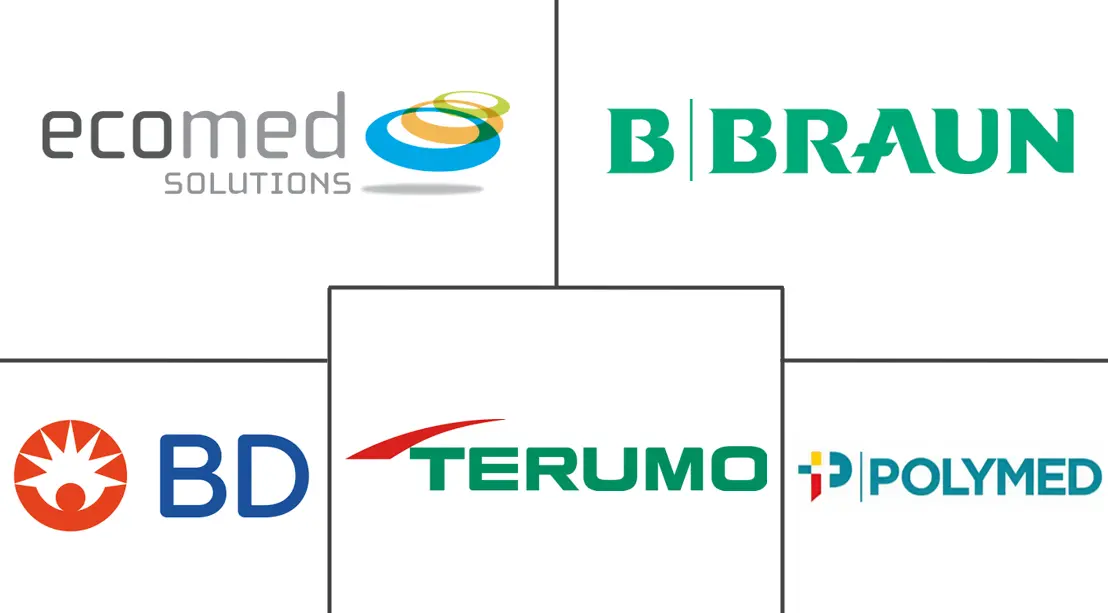Market Size of Global Blood Transfusion Devices Industry

| Study Period | 2019 - 2029 |
| Market Size (2024) | USD 7.39 Billion |
| Market Size (2029) | USD 10.45 Billion |
| CAGR (2024 - 2029) | 7.19 % |
| Fastest Growing Market | Asia Pacific |
| Largest Market | North America |
| Market Concentration | Medium |
Major Players
*Disclaimer: Major Players sorted in no particular order |
Blood Transfusion Devices Market Analysis
The Global Blood Transfusion Devices Market size is estimated at USD 7.39 billion in 2024, and is expected to reach USD 10.45 billion by 2029, growing at a CAGR of 7.19% during the forecast period (2024-2029).
Market growth is being driven by several factors, including an uptick in surgical procedures, a rise in blood disorders, and technological advancements in transfusion devices. Blood transfusions are most commonly required in surgeries such as cardiovascular procedures, C-sections, and treatments for trauma and accident injuries. As the demand for blood in these surgeries grows, so does the need for blood transfusion devices.
For instance, data from the Health Sciences Authority (HSA) in September 2024 revealed that Singapore's national authority collected 122,668 whole blood donations and 8,378 apheresis donations in 2023. Furthermore, HSA noted that Singapore's hourly requirement is 14 units of blood, amounting to 325 units daily and a staggering 118,750 units annually. This underscores the heightened demand for blood, especially for surgeries, suggesting a corresponding rise in the need for blood transfusion devices and, consequently, market growth during the study period.
Blood-related disorders like leukemia, lymphoma, myeloma, and myelodysplastic syndromes (MDS) impact the bone marrow, blood cells, lymph nodes, and the broader lymphatic system. Apheresis technology has been pivotal in managing these conditions, especially in controlling white cell counts until other medications take effect. For instance, the American Cancer Society reported in January 2023 that the U.S. recorded approximately 59,610 new cases of leukemia and about 20,380 new cases of acute myeloid leukemia (AML) in 2023. Blood transfusions play a crucial role in replenishing red cells, platelets, and other components for patients with these disorders. Given the rising prevalence of blood-related diseases, the demand for blood transfusion devices is poised to grow, positively influencing market expansion.
In summary, the escalating demand for blood and the rising prevalence of blood-related disorders are set to drive the need for blood transfusion devices, fueling market growth in the coming years. Yet, challenges like stringent regulations and the high costs of managing blood and its components could temper this growth.
Blood Transfusion Devices Industry Segmentation
As per the scope of the report, blood transfusion is a process in which blood and blood products are collected and transfused into one’s circulation intravenously. Blood transfusion devices include medical devices used in the collection, processing, separation, and preservation of blood and blood products.
The blood transfusion devices market is segmented by product, end-user, and geography. By product, the market is segmented into blood bags and accessories, blood mixers, filters, blood component separators, apheresis devices, pathogen reduction systems, consumables and supplies, and other products. By end-user, the market is segmented into hospitals, ambulatory surgery centers, blood banks, and other end-users. By geography, the market is segmented into North America, Europe, Asia-Pacific, the Middle East and Africa, and South America. The market report also covers the estimated market sizes and trends for 17 different countries across major regions globally. The report offers the value (in USD) for the above segments.
| By Product | |
| Blood Bag and Accessory | |
| Blood Mixer | |
| Filter | |
| Blood Component Separator | |
| Apheresis Device | |
| Pathogen Reduction System | |
| Consumables and Supplies | |
| Other Products |
| By End-user | |
| Hospital | |
| Ambulatory Surgical Centres | |
| Blood Bank | |
| Other End-users |
| Geography | ||||||||
| ||||||||
| ||||||||
| ||||||||
| ||||||||
|
Global Blood Transfusion Devices Market Size Summary
The Blood Transfusion Devices Market is poised for significant growth, driven by an increasing number of surgical procedures, accidents, and trauma cases, alongside a rise in blood disorders. Technological advancements in the field are further propelling market expansion. The demand for blood transfusion devices is particularly influenced by the growing rates of cesarean sections and the prevalence of blood cancers such as leukemia, lymphoma, and myeloma. The market is also witnessing a surge in the adoption of innovative technologies, such as apheresis and pathogen reduction systems, which enhance the safety and efficacy of blood transfusions. These advancements are crucial in addressing the challenges posed by the COVID-19 pandemic, which had initially disrupted blood supply chains and donor confidence.
The competitive landscape of the Blood Transfusion Devices Market is moderately dynamic, with both established players and emerging companies striving to enhance their market presence through product innovation and strategic collaborations. Key market participants, including Terumo Corporation, Ecomed Solutions, LLC., and Becton Dickinson and Company, are actively engaged in launching new products and expanding their offerings to meet the rising demand. The market's growth trajectory is supported by regulatory approvals and the introduction of cost-effective solutions, such as Vitestro's autonomous blood collection device and Cerus Corporation's INTERCEPT Blood System. Despite challenges like stringent regulatory frameworks and high operational costs, the market is expected to continue its upward trend, driven by the increasing need for safe and efficient blood transfusion solutions.
Global Blood Transfusion Devices Market Size - Table of Contents
-
1. MARKET DYNAMICS
-
1.1 Market Overview
-
1.2 Market Drivers
-
1.2.1 Increasing Number of Surgical Procedures
-
1.2.2 Rise in the Number of Blood Disorders
-
1.2.3 Technological Advancements in the Devices
-
-
1.3 Market Restraints
-
1.3.1 Stringent Regulatory Framework
-
1.3.2 High Costs Associated with Handling of Blood and its Components
-
-
1.4 Porter's Five Force Analysis
-
1.4.1 Threat of New Entrants
-
1.4.2 Bargaining Power of Buyers/Consumers
-
1.4.3 Bargaining Power of Suppliers
-
1.4.4 Threat of Substitute Products
-
1.4.5 Intensity of Competitive Rivalry
-
-
-
2. MARKET SEGMENTATION (Market Size by Value – USD)
-
2.1 By Product
-
2.1.1 Blood Bag and Accessory
-
2.1.2 Blood Mixer
-
2.1.3 Filter
-
2.1.4 Blood Component Separator
-
2.1.5 Apheresis Device
-
2.1.6 Pathogen Reduction System
-
2.1.7 Consumables and Supplies
-
2.1.8 Other Products
-
-
2.2 By End-user
-
2.2.1 Hospital
-
2.2.2 Ambulatory Surgical Centres
-
2.2.3 Blood Bank
-
2.2.4 Other End-users
-
-
2.3 Geography
-
2.3.1 North America
-
2.3.1.1 United States
-
2.3.1.2 Canada
-
2.3.1.3 Mexico
-
-
2.3.2 Europe
-
2.3.2.1 Germany
-
2.3.2.2 United Kingdom
-
2.3.2.3 France
-
2.3.2.4 Italy
-
2.3.2.5 Spain
-
2.3.2.6 Rest of Europe
-
-
2.3.3 Asia-Pacific
-
2.3.3.1 China
-
2.3.3.2 Japan
-
2.3.3.3 India
-
2.3.3.4 Australia
-
2.3.3.5 South Korea
-
2.3.3.6 Rest of Asia-Pacific
-
-
2.3.4 Middle East and Africa
-
2.3.4.1 GCC
-
2.3.4.2 South Africa
-
2.3.4.3 Rest of Middle East and Africa
-
-
2.3.5 South America
-
2.3.5.1 Brazil
-
2.3.5.2 Argentina
-
2.3.5.3 Rest of South America
-
-
-
Global Blood Transfusion Devices Market Size FAQs
How big is the Global Blood Transfusion Devices Market?
The Global Blood Transfusion Devices Market size is expected to reach USD 7.39 billion in 2024 and grow at a CAGR of 7.19% to reach USD 10.45 billion by 2029.
What is the current Global Blood Transfusion Devices Market size?
In 2024, the Global Blood Transfusion Devices Market size is expected to reach USD 7.39 billion.

